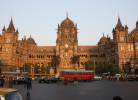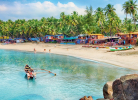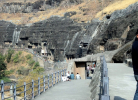Famous Temples Near Mumbai
Mumbai is a land of significant cultural differences and unique blend of living style. This is due to the fact that people from other parts of the country moved towards Mumbai for fulling their dreams and for finding jobs. This cultural hotspot’s significance spread around it too.
Many temples were erected over the period of time by many communities. Beyond this reason, many interesting pilgrimage destinations happen to be around Mumbai and many exclusive temples have been erected in those destinations, several centuries before the beginning of Mumbai.
If you are planning to cover destinations around Mumbai on a pilgrimage trip, here are the top temples to enjoy.
1. Shirdi Sai Baba Temple
Distance from Mumbai : 238 km
History
Entire city of Shirdi is considered as the land of Shri Sai Baba. This temple is located in Shirdi village of Maharashtra. Built in 1912, this temple’s main deity is an incarnation of Lord Shiva, Sai Baba. Teachings of Sai Baba are a mixture of Hinduism and Islam. He preached people and made miracles happen in this city.
When he died in 1918, his remains were buried in Buti wada and a temple was built in that spot. On his deathbed, he promised to his followers that he would guide them from his grave.
Things to Know
More than 25,000 people visit the temple every day. The temple is famous for aesthetically pleasing decoration of the deity in royal clothes, gold crowd, flower garlands and others.
The interior of the temple is made with stone bricks but, the spire of the temple is made with gold. Four main rituals take place every day. On every Thursday, a palanquin procession starts from the Samadhi Mandir to the temple via Dwarkamayi and Chavdi.
2. Nashik Kalaram Temple
Distance from Mumbai : 168.2 km
History
This is a very ancient and quite important temple in the country. As the name indicates, the deity in this temple is in Kala (black) color. The main deity of the temple is Lord Ram.
You can also find statues of Goddess Sita and God Lakshman. This temple was built in 1788. The construction of this temple started when Odhekar, a rich man had a dream of finding a statue near the River Godavari. He attempted a search and found the deity. He funded to build a temple for the deity.
Things to Know
Every day, seven different rituals take place in this temple. If you are looking for grand celebrations, visit the temple during any festival related to Lord Ram like Ramanavami or Ram Navratra.
On the 11th day of Month of Chaitra, a grand procession takes place from the temple, which is attended by millions of people. The temple is open from 5:30 am to 10 pm.
The main structure of the temple has an astounding architecture. It is said that the best stones from Ramshej Hills were brought and tested by boiling it in milk before using it for construction.
The temple has 96 pillars and the top of the spire of the temple is built with 32 tons of gold. The temple took 12 years to complete and the place looks ravishing after sunset.
3. Ganpatipule – Swayambhu Ganpati Temple
Distance from Mumbai : 340 km
History
Ganpatipule is a beach destination, which is quite famous for its temple and legends related to Lord Ganesh, the Elephant God of Hinduism. The temple in Ganpatipule is called as Swayambhu Ganpati temple.
The main deity is said to be formed by nature, 1600 years ago. There is another deity in the temple, which is made out of copper. The copper idol represents Lord Ganesh riding on a lion.Sunset rays fall on the idol and illuminates it, every day.
This temple is more than 400 years old and is considered to one of the rare temples of India as the deity in the temple faces west. Every year, thousands of people visit this temple and it is one of the most serene temples to find peace in the region.
Things to Know
Tourists who visit this temple also take a trip to the beach to enjoy the nature. This is one of the famous Ganesh temples of Maharashtra. The best time to visit the temple is during any Ganesh festivals, importantly, the Ganesh Chaturthi.
The temple is located on the base of a small hill. Pilgrims have to hike for a few minutes to reach the temple.
4. Shani Temple, Shani Shingnapur
Distance from Mumbai : 292.5 km
History
This temple is famous for having the main deity of Lord Shani, one of the planets of the system. The planet Shani is considered as God of Justice, who can cause years of bad luck to those who are evil or for those whose birth star is corrupted by the wrath of Shani.
Those who have the curse of Shani visit this temple to get better. This temple is considered as Jagrut Devasthan, which means that the deity resides in living form inside the temple. The deity is said to be formed naturally and emerged out of the earth.
Things to Know
The temple is famous for its large deity. Do you know that the village houses do not have locks or doors? The locals believe that Lord Shani would punish anyone who tries to steal from the village and then do not need any other protection.
The temple gets more than 45,000 visitors per year.
During the new moon day, the temple will be jam-packed with pilgrims. If the new moon day falls on a Saturday, grand festivals will be conducted. Women are not allowed to enter the inner sanctum of the temple.
The best part of all is that the way to this temple is filled with sugarcane shops, which uses bulls to extract juice from the sugarcane. It is called as rasavanthy in the local area.
5. Trimbakeshwar
Distance from Mumbai : 170.5 km
History
This is an ancient temple located in the Trimbakeshwar region of Nashik. This temple is dedicated to Lord Shiva of Hinduism. This temple is considered as one of the 12 sacred places of worship for Shiva devotees.
The temple’s pond is considered to be the origin of the great River Godavari (longest river of Indian Peninsular).
The crown placed on the deity is said to be during the time of Pandavas and it has many precious stones on it like diamonds, emeralds and others. The crown is on display on the deity only on Monday evenings.
This temple was built with Basalt and later, a large temple was built around the Basalt temple. The temple had a deity made of Nassak Diamond, which was looted by British during invasion.
Things to Know
The beauty of the temple is that it is located between three major hills and the temple has three lingams (form of Shiva). The three lingams represent the three main Gods of Hinduism. This temple is very famous among pilgrims who want to remove curse or sin from their souls. 7 km away from the temple, there lay a mountain named Anjaneri Mountain.
According to mythology, this mountain is the birthplace of Lord Hanuman.
6. Ganeshgule Beach And Temple
Distance from Mumbai : 358 km
History
This temple is more than 400 years old and the main deity of the temple is assumed to be Lord Ganesh. The deity in the temple is a naturally formed rock, which looks like Lord Ganesh.
A deep well is dug in this plateau, which provided water to the local area. As time passed by, the water dried up due to natural causes.
However, people believed that the God of the temple had left this premises and took over the Ganpatipule Temple.
Things to Know
Do not miss the Anjarle Creek and the seashore closer to the temple. The beach is covered with mountains on two sides. The clear sand beach and the mountain background make it a serene place to enjoy a peace time.
7. Grishneshwar Jyotirlinga Temple
Distance from Mumbai : 345 km
History
This temple is also called as the Dhushmeshwar temple. The main deity of the temple is Lord Shiva. This is last one of the 12 sacred temples of Lord Shiva. The temple has statues of Vishnu too, which is quite unique in ancient temple.
Although the temple was heavily damaged by Islamic invaders, this 13th century temple still stands, thanks to many renovation projects. The current temple structure was built in 18th century by Ahilyabai Holkar, Indoor queen.
Things to Know
Carved pillars of this temple are very famous for describing mythologies of Lord Shiva. This temple’s inner sanctum can be visited by anyone.
However, males have to enter bare-chested only. The structure of this temple represents the south Indian architecture. This temple is located very close to Ellora Caves, an important heritage site of the land.
8. Anjarle Ganesh Temple
Distance from Mumbai : 230.3 km
History
This temple is located a little away from Alibaug. The temple is located in the white beach of Anjarle village covered with coconut palms. This temple was built in 12th century.
During ancient times, the pilgrim visited the temple by crossing the river and climbing the hill. The ancient temple of 12th century was built entirely with wood. As time passed by, the temple fell into wreck and was renovated in 18th century.
With the construction of the new bridge, vehicles are allowed up to the entrance of the temple. This temple is said to be a living temple, the temple in which the deity resides in a living form inside the temple. It is said that in the ancient times, there were three temples in this region and the temples were closer to the seashore.
Today, only one of them stands with passage of time.
Things to Know
While visiting the temple, take the stone staircase on the right to the temple to get to the top of it. From the top, you can get a clear panoramic view of the surrounding regions including the river. The beach is famous for water activities like swimming, wind surfing, parasailing, lagoon, swimming and others.
Birdwatching is an important activity in this beach. If you visit during evening, you can find fishermen auctioning their catch. Many shacks serve fresh fish delicacies during evening.
Cashew nuts and mangos are available in abundant during summer season in this region. The best time to visit the temple is during January and February and, between April and May.
9. Yamai Devi temple, Aundh (Near Satara)
Distance from Mumbai : 293 km
History
Yamai Devi temple’s main deity is Goddess Mahalaxmi. The deity is called as Ye Mai, which means ‘Mother, please come’. The temple’s deity is made in black stone and the goddess is seen sitting in cross-legged position.
The temple was built by the local families and the ruling family of the region presented a 7 kg gold crown, which is placed on top of the temple’s spire.
Things to Know
The temple can be reached by a small trekking trip through the small hill or ride in car via a wounding route. The temple is famous for a small museum, Shri Bhavani Museum. This temple holds the artistic royal collection of antiques of the kings of Aundh.
The museum is located on the route to the temple. The museum holds many statues, paintings, structures and others.
10. Jejuri Temple (Near Pune)
Distance from Mumbai : 200.6 km
History
Jejuri temple is also called as the Khandoba Temple. Khandoba is a reincarnation of Lord Shiva. This warrior king was prayed as Bhairava, the fierce form of Lord Shiva.
There are more than 400 such temples in the country and the one such temple is located on top of Jejuri Hill. This deity is the prime God of tribal, farmers, hunters, shepherds and some communities of Brahmin. It is said that when Aurangazeb, Mughal ruler tried to invade the temple, the deity drove him out with his powers and this has led to some Islam communities to become devotees of Khandoba. The Muslims worship him as Ajmat Khan.
Things to Know
The temple is famous for serving vegetarian dishes and goat meat to God and the same would be served to the pilgrims. According to the new law, the goat meat is sacrificed outside the temple.























